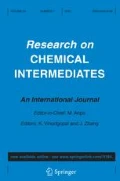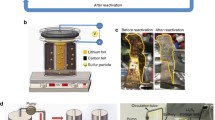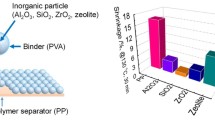Abstract
The suppression mechanism of the self-discharge reaction in nickel-metal hydride batteries using a sulfonated polyolefin separator was investigated with sealed-type AA size cells. The experimental results indicate that a sulfonated polyolefin separator effectively suppresses the self-discharge reaction in nickel-metal hydride batteries by trapping nitrogen-containing redox shuttle substances. It is also found that a sulfonated polyolefin separator traps the shuttle substances as gaseous ammonia. In the experiment examining the influence of the amount of the shuttle substances on the self-discharge, the starting point of the self-discharge agreed well with the point at which the nitrogen adsorption capacity of a sulfonated polyolefin separator reached its maximum.
Similar content being viewed by others
References
O. Bitsche and G. Gutmann, J. Power Sources 127, 8 (2004).
I. Yonezu, in: Proceedings of the Second International Advanced Automotive Battery Conference, p. 26 (2002).
M. Verbrugge and E. Tate, J. Power Sources 126, 236 (2004).
Y.-F. Yang, J. Power Sources 75, 19 (1998).
A. Taniguchi, N. Fujioka, M. Ikoma and A. Ohta, J. Power Sources 100, 117 (2001).
P. Gifford, J. Adams, D. Corrigan and S. Venkatesan, J. Power Sources 80, 157 (1999).
Y. J. Kim, A. Visintin, S. Srinivasan and A. J. Appleby, J. Electrochem. Soc. 139, 351 (1992).
P. H. L. Notten, W. S. Kruijt and H. J. Bergveld, J. Electrochem. Soc. 145, 3774 (1998).
P. H. L. Notten and J. R. G. van Beek, Chem, Ind. 54, 102 (2000).
M. Ikoma, Y. Hoshina, I. Matsumoto and C. Iwakura, J. Electrochem. Soc. 143, 1904 (1996).
P. Leblanc, P. Blanchard and S. Senyarich, J. Electrochem. Soc. 145, 844 (1998).
J. A. Cook and I. M. Lancaster, Electrochem. Soc. Proc. 98-15, 55 (1998).
C. Iwakura, N. Furukawa, T. Onishi, K. Sakamoto, S. Nohara and H. Inoue, Electrochemistry 69, 659 (2001).
C. Iwakura, S. Nohara, N. Furukawa and H. Inoue, Solid State Ionics 148, 487 (2002).
C. Iwakura, K. Ikoma, S. Nohara, N. Furukawa and H. Inoue, J. Electrochem. Soc. 150, A1623 (2003).
M. Oshitani, M. Yamane and S. Hattrori, J. Power Sources 8, 471 (1980).
Author information
Authors and Affiliations
Corresponding author
Rights and permissions
About this article
Cite this article
Shinyama, K., Harada, Y., Maeda, R. et al. Suppression mechanism of the self-discharge reaction in nickel-metal hydride batteries using a sulfonated polyolefin separator. Res Chem Intermed 32, 453–459 (2006). https://doi.org/10.1163/156856706777973673
Received:
Accepted:
Issue Date:
DOI: https://doi.org/10.1163/156856706777973673




